About
Nigerian Dwarf Goats
Nigerian Dwarf goats are a miniature breed of dairy goat. They are a breed of African origin. They are expressive and sociable little creatures who win people over in a heartbeat.
ABOUT NIGERIAN DWARF GOATS
The Nigerian Dwarf goat is a miniature Dairy goat of West African origin. These goats are enjoying a rise in popularity due to their small size, outgoing personality, colorful markings, and dairy characteristics.
Their small size means that they do not require as much space or feed as their larger dairy counterparts. Their friendly and gentle personalities make them excellent companion pets. Nigerians are very easy to handle even for small children, and are the perfect choice for novice handlers and hobby farmers. Nigerian dwarfs are considered a rare breed by the American Livestock Breeds Conservancy. The US Department of Agriculture has also approved the Nigerian Dwarf goat as a livestock dairy goat due to their high milk production per pound, which ultimately makes them eligible for youth 4H and FFA projects.
CONFORMATION
Nigerian Dwarf conformation is similar to that of the larger breed dairy goats. The body parts are in balanced proportion. The nose is straight, with a slight break at the eyes. The ears are upright. The coat is soft with short to medium hair. Ideal height is 17”-19” for does, and 19”-21” for bucks. Ideal weight is around 75 pounds. Oversized goats will be disqualified from show. Other faults are, curly coat, roman nose, pendulous ears, or fainting. Also, silver agouti markings (resembling a pygmy goat), is also disqualifying.
THE MINIATURE DAIRY GOAT
A healthy Nigerian Dwarf doe can produce a surprising amount of sweet milk for her size-up to 2 quarts per day or even more. In addition, Nigerian dwarf milk is higher in butterfat (6-10%) and higher in protein than milk from most dairy goat breeds.
NIGERIAN DWARF COLORING
Coloring is one of the factors that makes breeding these goats so popular. You can never predict what color combinations you will have. Nigerians are the most diversely colored of all of the goats. You will see:
spotted, 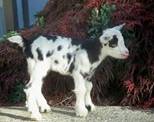 pinto,
pinto, 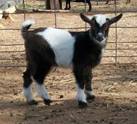
tri-color,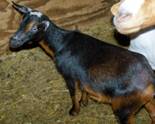
solid black or white, 
 chamoisee,
chamoisee, 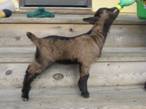
buckskin, 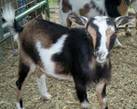 gold,
gold, 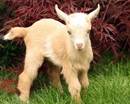 , or anything in between.
, or anything in between. 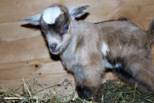
MANY ARE EVEN BORN WITH BRIGHT BLUE EYES!
CARE
They are easy to care for. They require little maintainance compared to other goat breeds. They crave companionship and have a great sense of humor.
Feed Requirements: Hay, Water, and loose GOAT mineral. Grain may be given as a treat or as a staple for growing, pregnant, or lactating females.
Space Requirement: Accoring to the NDGA each goat requires approximately 200 sq/ft of space for exercise.
Social Requirements: Goats require full time companions. They need to be a part of a herd.
Veterinary Requirements: Goats require routine veterinary Care. They should be vaccinated yearly for Clostridium Preferinges Types C&D and Tetenus. They should also be kept on a routine worming schedule.
Grooming Requirements. Goats should be bathed only for shows, brushed only when needed, and hooves trimmed as needed.
IN DEPTH GOAT CARE
Clean Fresh Water –ALWAYS
You can (if you would like) add 1 capful of vinegar per gallon of water if you feel she/he isn’t drinking enough water. Goats like vinegar. This especially wise, if you have wethers. The more water he drinks, the healthier his urinary tract will be. You must use a water heater in winter as goats will not drink water below 40 degrees Fahrenheit. Fresh clean water is the best thing you can do to maintain healthy goats.
Hay- I like to keep the hay racks full. I put out hay twice a day. If you can put it out once a day, and have a little left over at the next feeding, that is fine too.
Good quality Grass Hay is fed free choice at all times. The goat must have access to a good dry hay to keep healthy digestive tract. Hay should not have mold, dust or be left out in wet weather. A high quality grass hay will minimize illness, and reduce feed costs.
Minerals- You can buy a loose goat mineral (Southern States makes a great Goat mineral) or if you can’t find a loose mineral a salt block (brown, not white) is good to keep your goat healthy.
Salt blocks , I prefer the brown horse blocks that are higher in selenium and copper. It is inexpensive and helps them get all of the vitamins they need. If you start to have a copper deficiency, you will find that your goats black fur will start to have a reddish brown tinge to the tips of the hairs. Goats require more copper than most other farm animals. Do not use feeds/minerals specified for goats and sheep, as it is copper deficient. Sheep do not have the same mineral requirements as goats.
Feed/Grain- Not necessary for adult goats. May be harmful to males.
You may supplement your goats with a cup of goat feed daily if they are young or you feel they need it or are pregnant or nursing young. If you use grain, make sure it is specific to goats, and contains a substance called Ammonium Chloride. This is especially important for males/wethers. Ammonium Chloride will minimize the solidification of minerals in the bladder, and reduce the risk of goats developing stones called Urinary calculi. These stones are painful, and can even be deadly.
Vaccinations and shots- Our goats receive an annual booster for CD&T (clostridium preferinges types C and D plus tetanus).
They also receive 1cc (for adult goats) Ivomec 1% injectable for cattle (administered orally/by mouth) bi-monthly to eliminate worms. OR I like the horse grade oral ivomec gel that is apple flavored. It comes in tubes meant to dose 1250lbs. I use 1/12 of a tube per adult goat (about ¾ inch). It is less expensive, and the goats will eat it right off your finger.
Hooves and grooming-keep goats hooves neat and trimmed to prevent any infections or walking problems. I can show you how to do this.
THINGS TO ALWAYS HAVE ON HAND AND WHY
Ivermectin 1% Injectable for cattle
This is good to treat all types of worms when given orally or injected. When injecting, use 1ml/100 pounds. When giving orally, give 1ml/50 pounds. Can also be used as a top coat to treat lice or other external parasites.
CD&T Vaccine (Clostridium Preferinges types C&D plus Tetanus) this vaccine should be given at birth, at age 4 weeks, and again around 8 weeks. After that, it should be boostered yearly and used when a goat is injured or has a medical procedure. (like you receive a tetanus vaccine when you get a bad cut).
PROBIOS This is an oral supplement available commercially that is made to replenish healthy gut flora. It is used to repopulate the rumens healthy bacteria when a goat is stressed or anti-biotics have been administered. Follow dosing instructions on the package.
BAKING SODA This can be offered free choice. Goats will eat this to help regulate the pH of their rumens. It helps prevent acidosis, and improves any problems with indigestion. You can also dose your goats with this if you think they are not feeling well. You can make a paste and dose it orally.
Pro-Pen G This is the antibiotic Penicillin. It is useful to use after a difficult kidding or when you suspect a goat may be developing pneumonia. Always make sure that when you give penicillin, you follow up with a dose of ProBios.
Vitamin B complex with Thiamine This is good to give a doe that has just delivered babies, or can be used to boost a goats appetite. It is also a good treatment for Goat Polio.
Molasses This ia a great trick to get a stressed animal to eat and drink. It can either be put on/under the tongue, or diluted in warm water.
Iodine This is good for dressing wounds and dipping navels of newborns to prevent infections. We use 7%.
C&D Anti-toxin Used to treat Enterotoxaemia.
CHART OF COMMON GOAT DISEASES
Disease / CondiSymptom
Acidosis – occurs after accidentally taking in large quantities of concentrate foodstuffs “OVER EATS”
Symptoms- Depressed, hangs its head, drunken behavior, muscle twitching, bloat tends to occur, swelling on left flank, may grind teeth
Treatment- Stop access to food. Drench goat with something alkaline such as bicarbonate of soda. 2-3 ounces will help neutralize acid. BAKING SODA
Blackleg - (Clostridial Myositis) - caused by the soil-borne bacterium, Clostridium chauvei. The disease develops rapidly in affected animals and often deaths occur before the owner has noticed any sickness in the herd.
Symptoms- Often no symptoms are observed; At other times, high fever, lack of appetite, depression, lameness, swelled head, and swellings that appear in the muscles on various parts of the body. Sometimes the leg muscles are involved, or the muscles in the region of the back, hip, flank, chest or shoulder. In the latter stage of the disease, these swellings spread and become quite mushy, producing a characteristic crackling sound when pressed with the hand.
Treatment- May respond to immediate treatment with penicillin or other antibiotics in large doses. In swelled head, need to have vet aid in draining of affected area.
Bloat – VERY COMMON gorging on anything unsuitable such as wet grass pastures or after raiding food bin
Tightly inflated flanks, misery, collapse Drench with Mineral oil (6-8 fl oz) for an adult, (2+ fl oz) for kids. Walk goat about, massage flanks.
Breeder experiences
"Giving mineral oil is very effective in getting a goat that has over eaten grain to speed that grain on it's way. Vegetable oil will add to the digestive load, and may cause more harm than good. Mineral oil is not digestible, and I have used it with no problems at all. Feed that is overeaten ferments, causes gas, and acidosis to occur, which can lead to death. The object is to speed it out of there without adding to the digestive load." by Coni Ross
Another breeder's experience
"You wouldn't call me an expert on goats but I have had experience with the Bloating disease. To tell you the truth vegetable oil does work. I have personally used it on a couple of my bloated goats. I had amost a total of 3 of my kids die because of bloating, after the first one died I decided that it was time to get on the internet and do some of my own research. I came a crossed a web site that had information on bloating goats, and it said "If needed use vegetable oil", and it worked. I have used vegetable oil ever since. "
Amanda R. Wolfe
Bottle Jaw - Caused by animal being infected with blood-sucking worms. Fluids are leaking from blood vessels and flow to the lower parts of the body. As the animal grazes during the day, the fluids build up in the head. Over night the fluids may partially drain away from the head. Lower face and jaw will dramatically swell especially during the evening. Gums may not have the normal color because of being anemic. Your worming medicine may not be effective or you may not have wormed recently. The animal needs to be wormed with a strong medication every 11 days for three times. It may also be anemic and need iron and vitamins given. Their system will have difficulty fighting off problems so you should use an antibiotic for several days to help.
Usually a dose of Ivomec will help
Caprine Arthritis Encephalitis (CAE) – Virus. Infectious to others.
Knees become enlarged, lameness, weight wasting, hard udder. Pneumonia, chronic cough. Isolate and remove animal from herd. Not treatable, not present in my herd.
Caseous Lymphadenitis (CL) – Lumps opr bumps not associated with localized in jections are often suspected to be CL especially if localized near a lymph node. Infectious. Bacteria enters animal through break in skin or mucous membranes and localizes in lymph node
Abscesses of the lymph glands. NOT ALL abscesses are CL. Your vet can test the animals to see if the abscess is CL or not. Isolate and remove animal from herd. Many breeders will get rid of animals with CL.
This is VERY contagious. If you see an animal with curious lumps or bumps anywhere (even at a petting zoo), do not handle. Wash hands thoroughly and wash all clothes and footwear with bleach. Be ultra cautious not to expose your own animals. This disease can be passed from clothes/shoes to soil. Soil can remain infected for YEARS. Not curable, not present in my herd.
Coccidiosis – coccidia parasites. Usually a disease of young or stressed animals. Goats can get this from the environment, but can also get this from bad feed (or so I have been told).
Symptoms- Off food, diarrhea, blood in diarrhea, rapid weight loss, dehydration, may show straining in attempts to pass feces, dehydration and fever
Treatment- You can treat easily with Biosol. Depending on weight, follow directions on label. Dose adults orally once a day for 5-7 days. Another treatment is with Corid liquid. Mix half Corid and half water and drench with 1cc per 4 lbs for 5 days. Do not mix more than you will use in 3 days. WE HAVE NEVER HAD THIS HERE
Conjunctivitis or Pinkeye – infection of the eye spread by agents such as flies, dust and long grass. Can also be gotten from dusty hay.
Symptoms- A watery eye with excess tears spilling over on to the skin. May be reddening and cornea becomes cloudy. Animal sensitive to the light. May lead to blindness. Treat with ophthalmic antibiotic (Terramycin)ointment and consult a vet. This may be contagious to people.
Cystic Ovaries:Continues to come into heat every 4-5 days. She will fail to come into a true, standing heat, and she will act ‘bucky’ treat cystic ovaries quite successfully with an injection of HCG (Human Chorionic Gonadotropin, an Rx) to correct the hormonal imbalance. That is followed about 9-10 days later by an injection of Lutalyse
I have never had this problem here.
Enterotoxaemia –(overeaters disease) Clostridium perfringens type D bacteria produce the poisons responsible, when conditions in the digestive tract deprive them of oxygen.
Symptoms- Sudden loss of appetite. Depression and a drunken appearance. As it progresses the animal becomes unable to stand and lies on side making paddling movements. High temperature. Very watery diarrhea The prognosis for recovery is guarded in caprine enterotoxemia, even with treatment.
Treatment- Fluid therapy providing mixed electrolyte solution with bicarbonate are indicate in acute cases to counter shock, dehydration an acidosis.
Commercially available type C and D antitoxins should be administered. Antibiotic therapy may be helpful in reducing bacterial
proliferation. Oral sulfas have been used successfully Contact your vet.
Floppy Kid Syndrome -Some people believe it is caused by too much rich milk and others believe that it is associated with e-coli.
Symptoms- Newborn kids seem to do well for a few days after birth then start to show depression and weakness of limbs that progress to flaccid paralysis. Drunken appearance. No signs of diarrhea or elevated temperature. Possible distension of the abdomen.
Treatment- Remove kid from source of Milk immediately for 24 to 36 hours. Dissolve a teaspoon of sodium bicarbonate in a glass of water. With a syringe administer between 20 and 50 cc of the solution orally. Do it slowly so the kid has time to swallow. Repeat the treatment at 1, 3, 6, 12 hours from initial treatment. Feed electrolytes as alternative until returned to milk. Also administer a wide spectrum antibiotic to prevent secondary bacterial infections.
Or another Treatment is one-half tsp baking soda, mixed with electrolytes and one-half teaspoon Pepto-Bismol.
Repeat in 6-12 hours. Not required to pull from mother's milk from this solution's perspective
Third Solution - If the kid can still walk but is wobbly then give 2cc long-acting penicillin orally and 500MG thiamin. The Thiamin is mixed with the penicillin, and is imperative to recovery This should work in 6 hours. If the kid is comatose, give 5CC %50 dextrose orally and keep warm. Give the pen and thiamin for 3 days once a day.
Foot & Mouth Disease - viral disease of cloven-hoofed animals. Blisters or vesicles form in any of the following places: lips, tongue, teats, or the coronary band of the hoof. Tend to become lame and possibly salivate excessively. Must be controlled from occurring. Animals exposed to the disease are destroyed. Have never seen this but is useful info.
Foot Rot – Fusiformis nodosus infection enters the hoof and causes inflammation of the sensitive laminae.
Symptoms- Lameness, mild to severe. There is a foul smell associated with it. Animals are reluctant to walk.
Treatment Hoof paring in order to remove the under-run hoof. Apply antiseptic agents in order to remove any infection.
Gastro-intestinal roundworms – infest stomach and intestines sucking blood or reducing the absorption of digested food materials from the gut
Symptoms- Diarrhea and weight loss, anaemia
Treatment- Drench with dewormer medicine such as Ivomec, Cydectin. Make sure the worms are not resistant to your wormer.
Goat Polio - a Thiamine (Vitamin B 1) deficiency. From improper feeding, particularly feeding too much grain and too little roughage/hay.
Symptoms-Excitability, "stargazing", muscle rigidity, uncoordinated staggering and/or weaving, drunkenness, circling, diarrhea, muscle tremor, head against wall, and apparent blindness. A rapid, involuntary, oscillatory motion of the eyeball. As it progresses, convulsions and high fever may occur, and if untreated, the animal generally dies within 24-72 hours.
Treatment- Thiamine is the only effective therapy, and treatment can result in improvement in as little as two hours, if the disease is caught early enough. Dosage is related to body weight:
Use 500mg/ml Thiamin. Start with a gram (1,000 mg) IM the first dose, then at least 500mg per day for as long as it takes for complete recovery. Give 10cc Penicillin orally, and 10cc SQ at first treatment. Polio can be caused by plant thiaminase, or bacteria that either inhibit production of thiamin in the goat's gut, or consume the thiamin. Since we don't know what the origin is, It is preferred to sterilize the gut, and start over. So, the oral penicillin will kill the bacteria if that is the cause. On the morning of day 2, calf pac the goat, and give 500mg Thiamin orally, and 500mg SQ. Do not repeat any of the penicillin. If the goat will eat, feed her. If she can't eat, tube her or drench her with 100cc of Revive, 100cc of water several times a day until she can eat. Never had this, but info is useful.
Indigestion -- failure of normal rumen movement. Associated with high intake of concentrate foodstuffs (alfalfa, wet grass).
Symptoms- Off of food, slightly dull Generally recovers within two days. Sodium bicarbonate given by mouth may be of some use if there is a tendency to acid conditions in the rumen.
Treatment- Offer animal a quart of salt water with 25 g of sodium bicarbonate dissolved in it.
Johne’s Disease – chronic incurable infection of the intestines by Mycobacterium johnei bacterium. Causes a thickening of the intestine
Symptom-Loss of condition, occasional scouring, becoming more frequent with bubbles of gas in the droppings. Weakness. Thirst may increase.
Treatment-None. Slaughter animal as soon as possible to prevent spread to other animals.
Ketosis – Lactating doe is unable to obtain large amounts of energy from feed and Ketones accumulate in the blood as body breaks down fat stores to maintain.
Symptoms- Goes off food. Milk yield falls. Sweet smell in the goat’s breath
Treatment- A glucose or treacle drench may be given. Corticosteroid drug and oral propylene glycol.
Lice – parasite
Symptoms- Intense irritation, rubbing, bald patches and itching, usually during the winter months Louse powder will normally control the problem. Insecticides for spray or dip repeated. I top coat with Ivomec, or I use Frontline. It seems to work, but is not approved for goats.
Laminitis - inflammation of the skin layers around the hoof. Often caused by consumption of a highly concentrated or lush forage diet. It may also be associated with sicknesses such as pneumonia, mastitis, and metritis.
Symptoms- Lameness and warm feet. Moves with a stiff gait, prefers to lay down or stay on knees. May also show signs of bloat, diarrhea and toxemia
Treatment- Place on a reduced protein/energy diet such as hay with a very reduced or not concentrate ration and soft bed for lying down. Pain relief with a Non-steroidal anti-inflammatory drug such as Phenylbutazone is essential. Chronis cases need careful foot trimming to relieve pain by reducing pressure on the sensitive areas.
Listeriosis - caused by the bacteria Listeria monocytogenes, found in soil, water, plant litter, silage and goat's digestive tract. Brought on by feeding silage, sudden changes in kind of feed, parasitism, dramatic weather changes and advanced stages of pregnancy.
Symptoms- Depression, decreased appetite, fever, leaning or stumbling or moving in one direction only, head pulled to flank with rigid neck, facial paralysis on one side, slack jaw, and drooling, abortions. Treatment- Administration of Procaine penicillin (Pro Pen G) every six hours for three to five days, then daily for an additional seven days. Don’t forget the Probios as well.
Lungworms – worms inhabit the air passages and cause inflammation (parasite pneumonia)
Symptoms- Chronic cough
Treatment- Drench with dewormer such as Ivomec
Mange, Chorioptic – Chorioptes caprae infest the skin of the lower leg
Symptoms- Itchiness may be noticed and there may be small crusty scabs.
Mange, Demodectic – Demodex caprae invade the hair follicles and sebaceous glands of the skin
Symptoms- Small lumps are noticed in the skin. They may be like a cyst or bag of fluid. Response to treatment is generally poor. Discuss with your veterinary.
Mange, Psoroptic – Psoroptes caprae which infests the ears
Symptoms- May cause head-shaking and scratching. Gamma benzene hexachloride and gammexane can be used
Mange, Sarcoptic – Saroptes scabei burrow in the skin and lay their eggs in tunnels
Symptoms-Terrible itching, Skin becomes raised, red and hairless round the eyes, ears and nose. Infestation can be passed to other goats. Veterinary treatment is required.
Mastitis - inflammation of the udder, almost always associated with germs
Symptoms-Misery, udder hot, hard and very tender, appetite lost, pupils of eyes narrowed to slits
Treatment-Antibiotics, and supportive therapy
Mastitis (gangrene) - inflammation of the udder, almost always associated with germs bruised looking udder.
Treatment- Doe show signs of generalized illness: depression, fever or loss of appetite. Gangrene mastitis should be suspect if the udder is cold, swollen with an excessive accumulation of fluid and the milk is watery or bloody.
Treatment -veterinary care is necessary, some people give:
- CD antitoxin -7cc SQ
- Poly Serum - 10cc SQ
- 10cc Penicillin SQ & 5cc IM,
- Banamine - 1cc/100lbs IM
- follow with 10cc Penicillin SQ per day for 5 more days.
- If you have Nuflor, give her 6cc/100lbs SQ first day, and 3cc/100 for at least 5 days more
This type of Mastitis is a true emergency. If you catch it fast enough, you may actually save the udder.
Mycotoxin - "Myco means fungus and toxin means poison" - a poisoning of an animal from a fungus growth normally in old hay or feed.
Symptoms- Excessive salavation, depression, anorexia, convulsions, arched back Varies according to the source of problem.
Treatment- Remove the "bad" feed or hay from the animals immediately. Administration of activated charcoal may inhibit additional uptake of toxin from the gut. Mineral oil may help. This is why it SO important to know your hay and get it from a trusted source.
Navel Ill – dirty environments infecting the navel cord after birth
Symptoms- Young kid with swollen, painful navel which may look red Treatment- te key is prevention. All navals should be dipped in iodine at birth to prevent this. However, if a kid gets it, they need Antibiotic injections. Area around the navel should be cleaned with antiseptic iodine, crusty scabs removed by soaking and any pockets of pus drained.
Pneumonia – infection of the lung
Refuses food, stands around hanging head down, sounds congested, elevated temperature, and coughs and breathes rapidly or with difficulty. Antibacterial drugs such as Oxytetracycline. May require veterinary-only drugs if severe.
Pregnancy Toxemia - a metabolic disease of does in late pregnancy. Most of the nutrition is going to the kids. Similar to Ketosis. Ketosis is after birthing.
Lethargy and losses of appetite over one to two weeks, generally in very late pregnancy. Limping or swelling of feet. Laying around not wanting to get up. Sweet-smelling (ketotic) breath. Ketosis strips can be used to identify if the doe is ketotic Give doe propylene glycol twice a day. We give 60cc drench in am and pm. We also create a mixture of sodium bicarbonate with water and give 30cc drench am and pm. Help get the doe up and moving around during the day and offering food.
Another Solution Give her 3 Tbs Calf Pac mixed with 100cc Revive and 100cc water. Give the doe 200cc of Revive every 2 hours, with Calf Pac in it. Also, once you get the doe awake, always give alfalfa, and corn with the sweet feed. Give her at least 6-8 oz. Magic at night to hold them.
Ringworms – Fungal condition
Grey-white crusty appearance on small areas of skin. Skin is usually thickened and the hairs thin or absent. Generally no itching or evidence of irritation. Enlargement of affected areas occurs. Fungicidal preparations applied as a liquid dressing. Any of the following daily for five days and then weekly:
- 0.5% Lime sulphur
- 1:10 bleach
- 1:300 Captan
- 1% Betadine
(Sore Mouth) –- Highly infectious viral disease to animals and humans. ORF is the name for this in humans.
Pimples about the nose, mouth, eyes, anus and hoofs. Turning to watery blisters, then to sticky and encrusted scabs. Swelling of mouth and gums. Will run a course of around three weeks. Animals can die if they are unable to eat or nurse because of the sore mouth. Difficult. Dress with antibiotic spray or ointment. Isolate infected animals. There is a Ovine Ecthyma Vaccine against sore mouth infection to all animals. Vaccine to infected animals may reduce the time to recover. We do not recommend vaccinating. We let the soremouth run its course of 3 weeks and doctor severe cases. We use medication with Cephapirin Benzathine in it. Two brands are Cefa-Dri and Tomorrow. CHX-Guard LA gel antibacterial agent adheres to the gums of infected animals.
Tapeworms – inhabit the small intestine
Examination of the goat’s droppings. Young goats will pass tapeworm segments in their feces during the summer months. An anthelmintic such as albendazole can be used. Oral niclosamide is highly effective.
Tetanus - Infection of open wounds by the bacterium Clostridium tetani results in tetanus (lockjaw)
A general increase in muscle stiffness is seen, causing an unsteady gait. Eyelid begins to extend over the eye and animal looks "anxious". The symptoms get progressively worse and convulsions may occur. The goat dies because it is unable to breathe. Goats can be treated with antibiotics such as penicillin and antisera, but response is poor. The site of bacterial proliferation should be searched for and whenever possible, the wound or infection site should be opened to the air, debrided, flushed with hydrogen peroxide and infiltrated with penicillin. The area be infiltrated with tetanus antitoxin before the wound cleaning process is begun to reduce the chance that more pre-existing toxin will b absorbed during tissue manipulations.
Urinary Calculi - A hard mass of mineral salts in the urinary tract caused by a dietary mineral imbalance, usually in bucks
Restlessness, straining to urinate, pawing the ground, recurrent looking at its own abdomen, vocal signs of pain Most treatment must be done by veterinarians. Often requiring the removal of the tip of the penis. Look at the details in the article on Urinary Calculi
White Muscle Disease - deficiency of Vitamin E and Selenium
Stiffness, weakness and trembling. Back legs become stiff and unable to use. Can result in death Administration of selenium, together with vitamin E.
Link to a map showing counties Selenium levels
http://tin.er.usgs.gov/geochem/doc/averages/se/usa.html
BREEDING
Nigerians, originating from the warm climate of Africa, are year-round breeders. They tend to breed more successfully in the fall, and general kid in the spring. however, they ARE capable of breeding year round.
Kids become fertile at a very YOUNG age. Bucklings, from my own experience, can successfully breed adult does at 7-8 WEEKS of age. Does should not become fertile until 5 months, but I have heard reports of does becoming pregnant PRIOR to 8 weeks of age.
Does should not be bred until they are AT LEAST 7 months of age and only if they have reached a sufficient size and maturity. Some people wait until they are 1 year before breeding.
Goats are pregnant for 145-155 days. This is approximately 5 months. Does may deliver multiple kids. In fact, the most common births are twins and triplets. Although, quads and quints are not unheard of.
KIDDING
Birthing Nigerians is generally considered easy, and is usually uneventful. I try to attend every birth here on our farm. All kids are boostered with CD&T at birth. We dip their navels in Iodine, and do an over all health exam upon birth.
Newborn kids are able to walk in a matter of minutes. They are up and feeding almost immediately. They require colostrum to help boost their immune systems. This is also called "first milk". Kids generally begin nibbling hay and grain at about a week old, and are ready to wean at 8 weeks of age.
Disbudding is the process of burning the horn buds on the kids. This is done at approx. 2-4 weeks of age by a state certified veterinarian. A local anesthetic is applied, and the doctor uses a specialized burning tool to cauterize the buds.
This process is an unfortunate necessity. It prevents the growth of their naturally occurring horns. Sometimes, it is common that bucks may grow what are called "Scurrs". These scurrs are very common and are a result of the buck hormones causing the residual horn material to grow out. They are generally harmless and can be cut back as needed.
Our kids here at The Wolverton Family Farm are DAM RAISED. However, upon request, we will provide you with a bottle baby at a young age.
Wethering is done upon request, but does not affect the price of a buck. However, If a goat has already been wethered, the price is generally lower than breeding stock. Prices are evaluated and assigned based on an individuals merits, worth, and of coarse supply/demand.